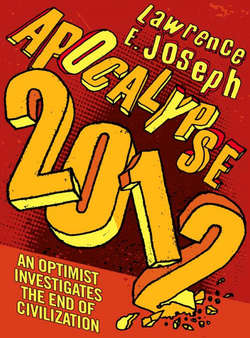Читать книгу Apocalypse 2012: An optimist investigates the end of civilization - Lawrence Joseph E. - Страница 9
COLLATERAL DAMAGE
ОглавлениеMaybe the most frightening apocalypse scenario of all is what’s happening in space. Talk about change being unthinkable. I mean, besides a few asteroids here and there, space is just there, right? It doesn’t change. Well, the whole Solar System is becoming increasingly agitated because we are moving into an interstellar energy cloud, according to an emerging Russian school of planetary geophysics. These scientists, who base their findings on decades of analyzing satellite data, have found that all the planets’ atmospheres, including the Earth’s, are beginning to show the effects of this massive input, both directly from the energy cloud and indirectly from the disturbances being created within the Sun from its encounter with the energy cloud.
Not to worry. The Earth’s atmosphere will protect us, right? Maybe in the old days it would have, but now Harvard and NASA scientists are reporting that California-sized cracks have inexplicably opened up in the Earth’s magnetic field, our essential shield against solar radiation and the deadly cancers and climatic disturbances that come with it. Some scientists are even predicting that a pole reversal, in which the North and South magnetic poles switch places, is imminent. That’s a several-thousand-year process in which multiple magnetic pole sites pop up around the globe, confusing and sometimes extinguishing the thousands of species of birds, fish, and mammals that depend upon magnetism for their sense of direction. During the confusion, the Earth’s magnetic protection drops to near zero, the cosmic equivalent of a very pale person getting caught on a beach in Miami with no hat, no shade, no sunblock, and an imperfect ass in a teeny Speedo.
One source of protection from excess solar radiation comes from another way the world might end. The sky could fill up with ray-absorbent ash, but that’s about the only good news I could find in a BBC documentary reporting that Yellowstone, probably the largest supervolcano in the world, is preparing to erupt. The last time Yellowstone erupted, 600,000 years ago, it vomited enough dust to cover the North American continent several feet deep. Today such an eruption would lead to a nuclear-winter-type scenario that would savage global agriculture and economy, killing hundreds of millions.
And the biggest reason to worry about the end of life is the prediction in Nature, perhaps the world’s most respected science journal, that at least three-quarters of the Earth’s species are wiped out every 62 to 65 million years. It has been 65 million years since the Cretaceous-Tertiary disaster extinguished the dinosaurs, meaning that we are now overdue for a cataclysm that will without doubt reduce our population by at least half, smash our infrastructure to smithereens, and drive most of whatever is left of our civilization underground.
If Yellowstone blows or the Sun’s acne festers into boils, ecological problems like ozone holes and global warming will be fondly lamented, the way we started out the 1980s worrying about herpes simplex and ended up with the scourge of AIDS. But the good news, as the irrepressible Admiral Hyman Rickover liked to point out, is that, whatever happens, “a new and wiser species will evolve.”
